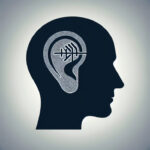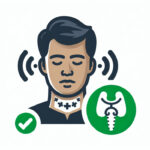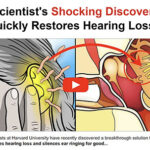This 30 Second Technique is Shockingly Effective
Breaking Down the Science of Mid Frequency Hearing Loss

Introduction to Mid Frequency Hearing Loss
Grasping the complexities of hearing impairments can be challenging, but understanding mid frequency hearing loss is critical for many individuals. This condition, unlike the more commonly discussed high or low-frequency hearing loss, specifically affects the middle range of sound frequencies, where many speech cues reside. Recognizing the nuances of mid frequency hearing loss is essential for both those experiencing it and their loved ones. With this knowledge, individuals can seek appropriate interventions that could drastically improve their communication abilities and overall quality of life.
Understanding Hearing Loss Basics
Hearing loss is a spectrum, varying in severity and frequency range. It can be sensorineural, conductive, or a mix of both, affecting how sound travels through the ear. Mid frequency hearing loss is unique in that it disrupts the ability to hear sounds in the middle frequency range, often between 500 and 2000 Hz, which includes many vocal sounds and everyday noises. This can make understanding speech particularly challenging, as it may affect the clarity of conversations without impacting the ability to hear louder or higher-pitched noises.
Defining Mid Frequency Hearing Loss
Mid frequency hearing loss, sometimes referred to as a 'cookie-bite' pattern due to its shape on an audiogram, is characterized by a dip in hearing sensitivity in the mid frequency range. Individuals with this type of hearing loss may not have trouble hearing low and high-frequency sounds, making it less noticeable initially. However, it can significantly affect one's ability to discern speech and may progressively worsen over time, underscoring the need for timely intervention and management.
The Importance of Addressing Mid Frequency Hearing Loss
Addressing mid frequency hearing loss is crucial as it can have a profound impact on communication and social interaction. Without proper management, it may lead to social isolation, frustration, and decreased quality of life. Early recognition and treatment can mitigate these effects, enhancing an individual's ability to engage with others and participate fully in daily activities. Awareness and understanding are the first steps toward effective management of this often-overlooked hearing impairment.
The Anatomy of the Human Ear and Mid Frequency Hearing Loss
The human ear is a marvel of engineering, intricately designed to process a range of sound frequencies. Sound travels through the outer ear to the eardrum, causing it to vibrate. These vibrations then move through the middle ear ossicles to the cochlea in the inner ear, where they are transformed into electrical signals for the brain to interpret. The precise processing of mid frequencies is vital for understanding speech, and disruptions in this pathway can lead to mid frequency hearing loss.
How the Ear Processes Mid Frequencies
Mid frequencies are crucial for distinguishing subtle differences in speech sounds, such as consonants, which provide clarity and meaning. In the cochlea, specific regions resonate with mid frequencies, allowing for the precise differentiation of these sounds. Damage or dysfunction in these regions can lead to difficulty distinguishing similar speech sounds, making it hard to follow conversations, especially in noisy environments.
The Role of Hair Cells in Mid Frequency Sound Transmission
Hair cells within the cochlea are the true workhorses of hearing, converting mechanical vibrations into electrical signals. Mid frequency sounds specifically rely on the health and function of certain hair cells located in a particular region of the cochlea. When these cells are damaged due to various factors, such as excessive noise exposure or ototoxic medications, their ability to transmit mid frequency sounds is compromised, leading to hearing loss.
Areas Affected by Mid Frequency Hearing Loss
Mid frequency hearing loss primarily affects the cochlea's ability to process sounds in the speech-relevant frequency range. However, it can also impact the auditory cortex's processing of sound, where the higher-level interpretation of auditory information occurs. This dual effect can result in a complex hearing deficit that's not just about volume but also about the clarity and comprehension of sounds, making effective communication a challenge.
Causes and Risk Factors of Mid Frequency Hearing Loss
Understanding the causes and risk factors of mid frequency hearing loss is fundamental in prevention and treatment. Several factors contribute to the development of this condition, ranging from environmental influences to genetic predispositions. By identifying these factors, individuals can take proactive steps to protect their hearing and seek early treatment when necessary.
Age-Related Changes in Hearing
As we age, our hearing naturally declines, a condition known as presbycusis. While typically affecting higher frequencies, age-related changes can also impact mid frequencies. The degeneration of hair cells in the cochlea over time can lead to a gradual reduction in hearing sensitivity, including in the mid frequency range, making early detection and management strategies critical for maintaining communication abilities.
Noise-Induced Hearing Damage
Exposure to loud noises, whether in the workplace or during recreational activities, can cause permanent damage to the hair cells in the cochlea. This noise-induced hearing loss can significantly affect mid frequencies, as these cells are particularly vulnerable to damage from excessive sound levels. Protecting ears from loud noises with appropriate hearing protection is essential for preventing this type of hearing loss.
Ototoxic Medications and Their Impact
Certain medications have ototoxic properties, meaning they can damage the auditory system. These drugs, including some antibiotics, chemotherapy agents, and NSAIDs, can lead to temporary or permanent mid frequency hearing loss. It is important to discuss potential side effects with healthcare providers and monitor hearing when taking these medications.
Genetic Predispositions to Mid Frequency Hearing Loss
Genetics can play a role in susceptibility to mid frequency hearing loss. Some individuals may inherit traits that make them more prone to hearing impairment, including specific vulnerabilities in the mid frequency range. Understanding family history can provide valuable insights into one's risk factors and prompt early monitoring and intervention.
Diagnosis of Mid Frequency Hearing Loss
Accurate diagnosis of mid frequency hearing loss is the first step toward effective treatment. Audiologists use a battery of tests to determine the presence and extent of hearing loss. Through these diagnostic tools, a tailored management plan can be developed to address the unique hearing needs of each individual.
The Role of Audiometric Testing
Audiometric testing is the cornerstone of hearing loss diagnosis. During a hearing test, an audiologist assesses an individual's ability to hear a range of frequencies at different volumes. A dip in hearing sensitivity at mid frequencies on an audiogram indicates mid frequency hearing loss. This detailed profile of hearing ability is essential for determining the appropriate intervention strategies.
Identifying Mid Frequency Hearing Loss Patterns
Identifying the specific pattern of mid frequency hearing loss is critical for understanding the underlying cause and guiding treatment. Audiologists look for the characteristic 'cookie-bite' pattern, but variations exist, and each pattern provides insights into the nature of the hearing loss. Comprehensive testing helps in creating a personalized approach to management and rehabilitation.
The Use of Tympanometry and Otoacoustic Emissions
Beyond audiometry, tympanometry and otoacoustic emissions (OAEs) are valuable tools in diagnosing mid frequency hearing loss. Tympanometry measures the middle ear's response to pressure changes, assessing its health and function. OAEs evaluate cochlear hair cell function by measuring sound echoes produced in the ear. These tests can help pinpoint the specific location and type of hearing impairment.
The Impact of Mid Frequency Hearing Loss on Daily Life
The consequences of mid frequency hearing loss extend far beyond the mechanical aspect of hearing. This condition can profoundly affect one's ability to communicate effectively, impacting personal and professional relationships and overall well-being. It's essential to understand these challenges to provide empathy and support to those affected.
Challenges in Speech Perception
Mid frequencies are critical for understanding speech, particularly in noisy environments. Those with mid frequency hearing loss may struggle to differentiate between similar-sounding words, leading to misunderstandings and frustration. This difficulty can be particularly taxing in group conversations, where multiple speakers and background noise compound the challenge.
The Effect on Social Interactions and Communication
Effective communication is the cornerstone of social interaction, and mid frequency hearing loss can put a strain on this fundamental human connection. Individuals may find themselves withdrawing from conversations and social settings to avoid the embarrassment and effort of trying to keep up. This social withdrawal can lead to isolation and a decline in mental health.
Coping with the Emotional Consequences
Dealing with the emotional impact of mid frequency hearing loss is a critical component of overall management. Feelings of frustration, embarrassment, and isolation are common. Seeking support from friends, family, or support groups can be invaluable, as can professional counseling. Acknowledging and addressing the emotional toll is as important as treating the physical symptoms.
Treatment and Management Options for Mid Frequency Hearing Loss
While mid frequency hearing loss presents unique challenges, there are several effective treatment and management options available. With technological advancements and personalized strategies, individuals can regain control over their hearing and communication abilities, leading to improved quality of life.
Hearing Aid Technologies and Their Effectiveness
Hearing aids are a mainstay in treating mid frequency hearing loss. Modern devices are highly sophisticated, offering features like selective amplification of mid frequencies, noise reduction, and directional microphones. These advancements significantly improve speech understanding and are tailored to each person's specific hearing loss pattern, enhancing their effectiveness.
Cochlear Implants and Bone Anchored Hearing Systems
For more severe cases or when hearing aids are insufficient, cochlear implants and bone-anchored hearing systems offer alternative solutions. Cochlear implants bypass damaged hair cells, directly stimulating the auditory nerve, while bone-anchored systems use bone conduction to transmit sound. Both options can restore access to mid frequency sounds and improve communication.
Assistive Listening Devices and Communication Strategies
Assistive listening devices (ALDs) complement hearing aids and implants by enhancing sound in specific environments, such as classrooms or theaters. Additionally, employing communication strategies like lip-reading or using visual cues can help those with mid frequency hearing loss navigate conversations more effectively.
Prevention and Mitigation Strategies
Preventive measures can significantly reduce the risk of developing mid frequency hearing loss, while mitigation strategies can help manage the condition if it does arise. Understanding these approaches is key for those at risk or already experiencing hearing loss.
Protecting Your Hearing from Environmental Noises
Protecting one's hearing from damaging environmental noises is crucial. Using earplugs or earmuffs in noisy settings can prevent hair cell damage. Limiting exposure to loud sounds and following the 60/60 rule when using headphones—60 minutes at no more than 60% volume—are practical steps everyone can take.
The Significance of Regular Hearing Check-Ups
Regular hearing check-ups can catch mid frequency hearing loss early, allowing for timely intervention. Audiologists recommend annual screenings, especially for those with risk factors such as a family history of hearing loss or consistent exposure to loud noises. Early detection is vital for maintaining hearing health.
Healthy Lifestyle Choices to Preserve Hearing
Maintaining a healthy lifestyle can also contribute to hearing preservation. This includes avoiding smoking, managing chronic conditions like diabetes and hypertension, and staying physically active. These factors can positively impact overall ear health and reduce the likelihood of developing hearing loss.
Conclusion: The Future of Mid Frequency Hearing Loss Management
The future is promising for individuals with mid frequency hearing loss, thanks to ongoing research and technological advancements. Hearing aid technology continues to evolve, providing more precise and user-friendly options. Research into the causes and treatments of mid frequency hearing loss is expanding our understanding and paving the way for innovative solutions. Raising awareness and education on hearing health is also vital, encouraging proactive measures and early intervention. With these efforts, those affected can look forward to a future where mid frequency hearing loss is a manageable condition, not a life-altering one.

Laura Henderson is a health enthusiast and has been interested in healthy and natural methods of eliminating tinnitus and restoring natural hearing for many years.










